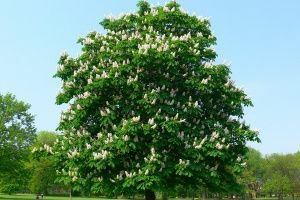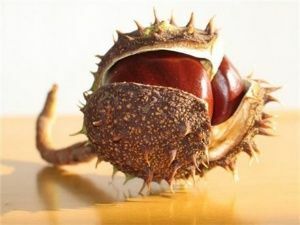 The massive, sweeping tree of the chestnut is fraught with many mysteries. In addition to the stunning spring bloom and shelter for some species of birds and insects, it benefits human health.
The massive, sweeping tree of the chestnut is fraught with many mysteries. In addition to the stunning spring bloom and shelter for some species of birds and insects, it benefits human health.
If you properly collect and prepare raw materials - you can save a lot on medicines. The correct use of horse chestnut is a matter that worries not only patients, but also physicians throughout the centuries.
Many recipes can be found in thick books. Here are some of them: a couple of tips that will come in handy for life!
Everything you need to have on hand
Unfortunately, our free medicine is sometimes too expensive. Therefore, with great care, we collect our personal home collection of recipes of folk medicine from all diseases. One of the first entries will be useful tips on the use of fruits and other parts of horse chestnut.
Tinctures cooked at home
How to prepare a useful decoction or tincture at home? The work will not take you much time. And the minimum costs will pleasantly surprise. Depending on the part of the chestnut that you choose to help, they are prepared as follows:
- The tincture of horse chestnut fruit( this is what everyone knows brown seeds) is prepared like this: one must take 10 ripe chestnuts, peel off the dark brown peel, finely chopand add about 500 ml of water. Place this mixture in a glass dish, covered with a dense lid. Leave it in a cool dark room( a cellar or a storage room is suitable).Then the most important thing is to forget about the existence of this potion for 7 days. A week later, everything is ready. To apply such a medicinal tincture it must be filtered.
- For those who do not want to wait for late autumn and fruit ripening period there is a spare option. Almost the same kind of tincture of horse chestnut, but only from flowers. The recipe is the same, but take 1 tablespoon of flowers.
Warning! To use better fit freshly flowers.
Broth from bark
Broth can be called a stretch, but in the literature such a medical fluid can be found under this name.
You need 2.5 teaspoons of chopped bark, you need to pour 250 ml of boiling water, insist for one hour in a water bath. Then the vessel is removed and gradually cooled at room temperature for 10 minutes, after which it is filtered and the drug is ready for use.
Preparation of broth from the bark of horse chestnut will take less time than tinctures. It is recommended to take it inside with diseases of the gastrointestinal tract( most often when there is stagnation of bile in the gallbladder), as a hemostatic agent with abundant uterine bleeding, but with the permission of the doctor.
Recommendations for the use of tincture
Thanks to the advantageous composition in one chestnut, saponin( escin), flavonoids, fatty oil, vitamins, protein substances and much more are available that can improve health. There are many legends about the miraculous recovery during the period of using the tincture. We'll figure it out - is it so!
Varicose foot disease
This disease can not but worsen the well-being of the beautiful half of humanity( and according to statistics, most of the patients suffering from such a disease are women).Of the most common causes of varicose veins, the following can be noted:
- Hereditary predisposition. The use of horse chestnut tincture in this case will be inappropriate and meaningless, as it will not save you from the reasons.
- Neuroendocrine diseases - a violation of the body's hormonal balance.
- Valve failure is an inadequacy of the valves of deep and superficial veins.
- Mechanical factors. Long standing work or severe physical activity provokes the development of the disease.
The use of horse chestnut tincture for varicose is justified in the latter case.
Do not forget! Before starting the treatment with horse chestnut, consult a doctor about the possible causes that led to the disease.
It is recommended to apply the tincture together with the main treatment. Of course, the expanded inconsistent veins will not disappear, but the well-being will improve due to the following effects:
- Eszin will remove the inflammation process, increase the tone of small and large veins. In addition, it has a stimulating and adaptogenic effect.
- Vitamin C increases the resistance of the vascular wall.
- Thanks to flavonoids, the fragility of capillaries decreases, the muscle layer of any vessel is strengthened.
- As a result of the use of horse chestnut in varicose, edema of the legs will significantly decrease, night convulsions, feeling of heaviness and fullness in the extremities will disappear. Reducing edema and strengthening the walls of blood vessels is also promoted by apple cider vinegar. About its numerous medicinal properties and application can be read here: Apple vinegar - a useful product! He will cure your even a difficult ailment.
What's important to remember! Treatment with tincture is recommended in the first and second stage of the disease, when there are no pronounced violations of the valve veins. The disease itself will not disappear, you can only remove some of the symptoms.
Much help for other diseases
The use of horse chestnut in folk medicine is not limited to two diseases. The range of action and therapeutic properties of this plant is much broader.
- The decoction is well used as an immunostimulating drink in the autumn-winter period.
- Trophic ulcers of the lower leg give in to an early healing after the application of the tincture.
- It is also used as an antithrombotic( anti-clotting) agent for diseases of the cardiovascular system.
- This unpleasant disease, like hemorrhoids, is also partially susceptible to treatment with tincture. Here the mechanism of action is the same as with varicose veins of the lower extremities.
- Add a couple of spoonfuls of broth in the diet can get rid of spring vitamin deficiency.
-
 The inflammatory process in the joints( arthritis and arthrosis of the first degree) will be significantly reduced if an external remedy is added to the main treatment - tincture.
The inflammatory process in the joints( arthritis and arthrosis of the first degree) will be significantly reduced if an external remedy is added to the main treatment - tincture. - The fruits of horse chestnut are used when the veins become inflamed, especially in the presence of thrombi in the affected vessels( thrombophlebitis).
- The tablets created on the basis of an extract have found application after the transferred or carried stroke.
- Atherosclerosis( a disease accompanied by a narrowing of the lumen of blood vessels) is also treatable with horse chestnut.
Side effects and contraindications
Not everything is as perfect as we would like. There are several negative points associated with the reception of a decoction or tincture of chestnut.
The following side effects are possible:
- Nausea.
- Vomiting.
- Pain in the heart.
- Rarely tearing.
- External application of the tincture increases the sensitivity of the skin to ultraviolet rays.
Hence contraindications to the use of horse chestnut:
- It is undesirable to use people with sensitive skin.
- Not recommended for pregnant and lactating women.
- With peptic ulcer diseases.
- In cholelithiasis.
- For children under 16 years.
In the fight against any disease means do not matter. There are situations when traditional medicine is powerless. In this case, one of the options for help may be a simple recipe for traditional medicine. The main thing is to go to its preparation with the mind and use it correctly.
